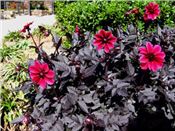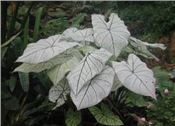Gardening Page
Summer Bulb Care & Planting Tips
When you say bulbs, most people think of spring blooming bulbs such as daffodils and tulips, but there is a whole range of summer bulbs that grace our gardens. Some are winter hardy and are grown as perennials, while others are tender and must be lifted and stored for the winter months.
Summer bulbs include elephant ears, caladiums, dahlias, gladiolus, lilies, lycoris (surprise lilies), amaryllis and pineapple lilies.
Summer bulbs can be just as easy to grow as daffodils and give you loads of color in foliage and/or flowers, and will actually bloom longer than their spring counterparts.
What are bulbs?
Bulbs are self-sufficient storage organs, and are versatile in the landscape. There are bulbs for partial shade as well as full sun. All bulbous plants have similar life cycles. They go through periods of growth and flowering, followed by a dormancy period. Bulbs are usually sold in their dormant, dry state. When planted, they being to initiate rooms, and the stems inside the bulbs begin to grow. The plants utilize their stored food reserves, and the shoots begin to emerge.
When they begin flowering, the storage organ or bulb, is empty of food. After bloom, they need to replenish the storage organ for the upcoming dormancy.
How do I choose bulbs?
When choosing bulbs ( or rhizomes, corms, and tubers, which we collectively call bulbs, and are generally planted in the same manner), look for large bulbs, which are firm and blemish free. The size of the bulb determines the size of the flower. Remember, everything is already contained inside your bulb when you purchase them. Quality bulbs will give you a wonderful show, and should keep giving for years with a little care. Bargain bulbs may not end up being such a bargain.
How do I plant bulbs?
When planting your bulbs, you can dig individual holes for each bulb (which can be difficult in our rocky soils) or mass plant. It is often easier to dig up a larger planting area, scatter your bulbs in, and then fill the soil back in. A general rule of planting depth is to plant two to three times the size of the bulb, deep in the ground.
Small bulbs are planted shallow, while big bulbs need a deeper hole.
You can layer different bulbs in the same planting area. Choose a site with good drainage–especially in the winter. Standing water and bulbs is not a good combination. When planting bulbs, grouping them together in clusters will make a stronger impact than a single row of bulbs.
What are some popular Summer Bulbs?
Caladiums
Caladiums are annuals and must be replanted each year, or they can be lifted and stored for the winter before a killing frost.
Some caladium bulbs will do well in full sun, but there are so many sun-loving options that one may relegate this bulb to the shade or partial shade areas of the garden. They will be up almost instantly in warm soils, since they are heat lovers. Caladiums are heat-loving plants, so don't be eager to plant them early in the spring. Planting caladiums in cold soil can stunt their growth cycle.
If you can’t find the bulbs, you can find caladium plants that are already growing in a pot. The foliage can come in shades of white, pink or red with many different leaf patterns. If you have heavy shade, you may consider choosing the light pink or white varieties to brighten things up.
Still have questions about caladium? Check out our reference desk Q & A Elephant Ears Lilies
Gladiolus
Amaryllis
The list above is just a sprinkling of summer bulbs, there are a wide range of others to choose from. Do your homework when planning your garden. Make sure you have something blooming in all seasons, and adding some of these low care summer-blooming bulbs into your summer- time mix will give you plenty of color.
Download the Landscaping Problem Guide
Additional Resources
· Reference Desk Q & A: Bulbs
· In the Garden in Arkansas
· Yard and Garden Resource Library
· Arkansas Home Landscaping Resources ∆

Braveheart is one of the black leafed dahlias that add a punch of color to the garden in the summer and fall.
Image courtesy Gerald Klingaman

Caladium